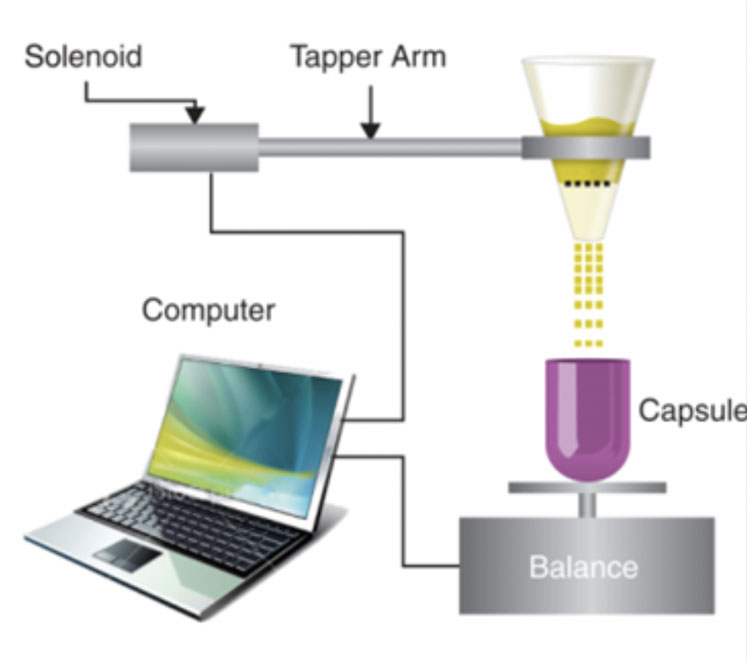Pharmaceutical and biotechnology drug development teams face numerous challenges when advancing active pharmaceutical ingredients (APIs) into marketable, life-saving medicinal products. The most pressing challenge is often time.
Candidate compounds can be costly during the very early stages of the selection and synthesis process, with limited availability of the API initial evaluations placing dosage form development timelines on a critical path.
The need for speed may be amplified because of targeted regulatory pathways — such as orphan drugs, breakthrough and fast-track designations — and the funding pressures faced by the small, emerging and virtual biopharma companies that hold the vast majority of early phase compounds today.
Precision powder microdosing systems facilitate the rapid manufacture of drug products in either API-in-capsule or -bottle formats
In many cases, these small biopharma companies engage clinical development and manufacturing partners for assistance to get products into human trials as fast as possible. A technology platform that has revolutionised the speed to clinic has been microdosing, an approach that has been broadly incorporated into first-in-human service offerings.
Precision powder microdosing systems facilitate the rapid manufacture of drug products in either API-in-capsule or -bottle formats for oral or pulmonary dosing in Phase I studies. By reducing or eliminating the need for excipient blends and their associated testing and evaluations, first-in-human studies can be reached up to 45% (13–17 weeks) faster than conventional formulation routes.
Microdosing can play a critical role in helping pharmaceutical and biotech companies to develop innovative products more quickly.
API in capsule or bottle: microdosing systems and approach
Microdosing is essentially the precision weighing and dispensing of powders into capsules or bottles using various specialised equipment platforms or techniques. API-in-capsule or -bottle studies start with API characterisation, from which an understanding of the API morphology, solubility and other key attributes define the drug product design and decision flow diagram.
Depending on the material’s physical attributes, API doses as low as 100 µg can be encapsulated with minimal variance in weight. Lonza Xcelodose Precision Powder Micro-Dosing Systems, first introduced in 2002, have been widely adopted for early phase API-in-capsule or -bottle studies.
Xcelodose systems have been designed for development and clinical-scale production with nameplate capacities of 120 and 600 capsules/bottles per hour (Xcelodose 120 or Xcelodose 600 systems), respectively, and with specialised capabilities for containment (S designation).

Figure 1: Xcelodose design principle
Figure 1 depicts the operating principles of this technology, whereby powder is dispensed through a mesh screen at the base of a dispensing head, based on precise tapping technology. Powder is released through the screen by the tapping action of a solenoid on the dispenser arm that cradles the dispensing head.
Parameters defining the tapping process can be tightly controlled and include dispensing head type, mesh hole size, number of holes, tapping frequency and desired dispense rate. These parameters are selected based on the physical characteristics of the material and desired dose.
The Xcelodose system accurately controls capsule- or bottle-dosing by continuously monitoring the net weight being dispensed in real-time and automatically adjusting the tapping rate during dispensing. As the weight approaches the target value, the rate of powder delivery is reduced and then eventually stopped when in the fill weight range.
The Xcelodose system can recognise and reject units that are under- or overweight based on the predetermined fill weight range
Once the dispensing operation is complete, the system can recognise and reject units that are under- or overweight based on the predetermined fill weight range. Comprehensive documentation for the filling operation, including the individual weights of each capsule or bottle produced in the run, are provided through software that fully meets the requirements necessary for its integration into a process compliant with 21 CFR Part 11.
Based on the experience of producing more than 750 batches of more than 250 compounds, Lonza has developed a range of best practices to optimise Xcelodose system efficiency and expand its range of application.
These best practices include high potency API (HPAPI) handling and containment considerations, the rapid translation of API analytical methods to API-in-capsule methods, specific approaches to API and capsule interaction considerations, sample preparation and capsule emptying techniques, and dispensing head adjustments necessary for excipient/excipient blends.
Case studies of microdosing applications
High-potency API (HPAPI): In a representative case study, the challenge presented was an HPAPI, low-dose application for initial clinical presentation on an aggressive timeline. The target dose for the clinical program was 0.1 mg fill weight into a size 1 capsule. Several fill evaluations were performed under containment to determine the appropriate dispensing head, tapping frequency and other parameters for a reasonable yield.
Through early experimental evaluations, the parameters were identified to produce capsules on the small-scale Xcelodose 120S and then transferred to the higher capacity Xcelodose 600S for GMP production. The yield for this operation was only 46%, which was expected as the fill weight was exceptionally low, although overage was produced to meet the desired quantity with minimal loss of API.
The clinical delivery date (overall programme from preliminary evaluations to clinical release dosage form in three months) was met.
Blends: Although not its primary application, microdosing can be utilised for blended formulations as well as neat APIs. Specific microdosing techniques are used to introduce blends into capsules or bottles as necessary. Dosing blended formulations with Xcelodose technology can be tricky because the tapping mechanics and gravity fill can introduce blend segregation, leaving analytical teams chasing a content uniformity issue during testing.
As the need for speed becomes even more prevalent in the drug development process, microdosing techniques are poised to continue to play a key role in the drug production toolkit for pharmaceutical and biotech companies
In a representative case study, the challenge presented was to provide a paediatric dose of 5 mg using a formulated capsule of 30 mg strength with a lower fill weight. The timeline challenges of this “one-time” batch did not warrant reformulation and additional stability studies.
To accommodate the blended formulation, tapping mechanics were adjusted, allowing the capsules to be successfully produced. Testing ensured uniformity of the dosage unit to meet the clinical delivery date, and the resultant development timeline for the reformulated paediatric capsule was reduced by an estimated four to six months.
In an additional and more challenging “API blend” case study, a comparator study was to be conducted with a commercially available immediate-release tablet versus a new API. The problem was that the tablets were of a much higher strength than what was required.
To address the need, tablets were milled to create an acceptable powder blend and then filled to the desired strength using an Xcelodose system. The capsules met acceptance criteria for assay and content uniformity and progressed to/ clinical dosing.
DPI applications: Microdosing can be used for dry powder inhaler (DPI) programmes using an API-in-capsule approach. Particle sizing is typically key for a DPI delivery system and specialised DPI capsules are often employed to provide optimised capsule clearance. Particle engineering is typically required for DPI applications to ensure an average particle size in the 2.5–3.0 µm range and a tight particle size distribution to optimise the respirable fraction.
Spray drying is increasingly being used to achieve the required particle size distribution and morphology for effective DPI therapeutic effect. Encapsulating spray-dried API using microdosing can rapidly advance dosage form development, using the same filling principles across multiple dosing ranges that allow for parameter optimisation, reducing weight variances and improving batch yields (Figure 2).

Scale-up considerations: Several technological advancements have been made with microdosing applications at commercial scale, which facilitate efficient late-stage clinical and/or commercial scale-up. Lonza has developed technology transfer best practices to expedite rapid scale-up from the Xcelodose system, primarily utilised for Phase I–II studies, to larger-capacity encapsulation systems for late-phase clinical- and commercial-scale production.
Lonza employs Harro Höfliger (Harro) encapsulation systems for larger-scale production, supporting both oral solid and DPI product development. These systems have high-speed, higher-volume capabilities that provide an efficient pathway to commercialising API-in-capsule formulations.
Although the Harro equipment uses a different feeder approach than the Xcelodose gravity fed system, API-in-capsule formulations can be readily scaled from Xcelodose-based Phase I–II studies.
These advancements have resulted in the ability to produce up to 72,000 capsules per hour based on the technology and powder properties
Harro fully automated devices can microdose powders using dosators and vacuum drums depending on the fill weight of the capsules. Harro Modu-C MS drum fillers, which Lonza employs, use custom-designed drums with precision-drilled holes and vacuum systems to produce low-impact forces and powders to introduce them into capsules at high rates of speed.
These advancements have resulted in the ability to produce up to 72,000 capsules per hour based on the technology and powder properties. Not only is application speed increased, the quality of the microdosing is maintained by a 100% inline fill mass monitoring and rejection.
The combination of Xcelodose systems, optimised for non-GMP development and GMP clinical production for Phase I–II studies, and Harro large-scale encapsulation systems for late-phase GMP clinical and commercial production, allows for rapid progression for encapsulated drug products. Lonza has successfully scaled-up products from Xcelodose technology to the fully automated Harro encapsulator and continues to refine technical transfer best practices.
Summary
Using API-in-capsule or -bottle approaches, biopharmaceutical companies have the ability to increase speed to clinic, quickly assess their new candidate compounds and remain cost-conscious to investments during the development of formulated dosage forms. Xcelodose-based systems have become an industry standard for rapid and accurate microdosing, and an integral part of accelerated pathways to first-in-human studies.
Best practices have been developed to expand the application range of Xcelodose-based microdosing and facilitate rapid transfer to large-scale encapsulation systems for late-stage clinical and commercial manufacture.
Choosing an integrated service partner, such as Lonza, which can provide drug substance, particle engineering and drug product services — including microdosing — can result in an average time saving of nine weeks through Phase II.
Additional time savings, as well as a reduction in the risk and complexity of working with multiple development and manufacturing partners, may be facilitated with integrated late-stage clinical and commercial-scale drug product development and manufacture.
As the need for speed becomes even more prevalent in the drug development process, microdosing techniques are poised to continue to play a key role in the drug production toolkit for pharmaceutical and biotech companies.

